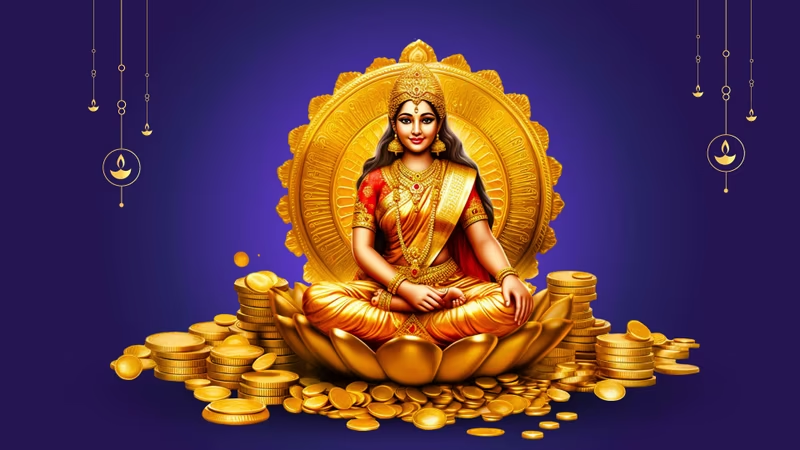Dhanteras, a significant celebration leading to Diwali, carries profound meaning and traditions.
This festival marks the thirteenth day of the waning moon phase and sets the stage for Diwali's grandeur. It is also known as Dhanavantri Trayodashi or Dhanatrayodashi, and its observance involves rituals called dhanteras puja vidhi and dhanteras puja.
On this significant day, people embark on dhanteras shopping, acquiring items such as utensils, jewelry, vehicles, and household appliances, believing it to be a great time to buy metals.
This act is not merely about commerce but is also a form of "puja on/for dhanteras," an offering to invoke blessings.
Dhanteras falls on the 13th lunar day (Trayodashi Tithi) of Krishna Paksha, or the Dark Fortnight, and is celebrated on November 10th this year.
Devotees dedicate this day to the worship of Goddess Lakshmi, beseeching her for happiness, prosperity, and wealth.
The puja on Dhanteras holds immense significance in Diwali celebrations.
Beyond material acquisitions, Dhanteras encompasses rich traditions and rituals focused on the well-being of households and the longevity of husbands. This includes lighting lamps, creating intricate rangolis, and adorning entrances with torans.
Additionally, some individuals also pay homage to Lord Yamaraj, seeking his blessings.
In addition to its "dhanteras gift" aspect, the festival carries deeper meaning, symbolizing hope, worship, and festivity as it heralds the beginning of the Diwali season.
In the following sections, we'll delve deeper into dhanteras meaning, significance, history, and captivating mythological stories.
Dhanteras Muhurat in 2023
Performing Lakshmi Puja on Dhanteras or Dhantrayodashi is recommended during the Pradosh Kaal, which commences after sunset and typically lasts for approximately 2 hours and 24 minutes.
It's important to note that choosing the Choghadiya Muhurat for Dhanteras Puja is not advisable, as those Muhurtas are more suitable for travel-related activities.
The best time for Lakshmi Puja on Dhanteras is during Pradosh Kaal when Sthir Lagna prevails.
Sthir means fixed i.e. not moveable. Performing Dhanteras Puja during Sthir Lagna is believed to invite the presence of Goddess Lakshmi into your home, making this period ideal for the worship.
Vrishabha Lagna, which is considered a Sthir Lagna, often coincides with the Pradosh Kaal during the Diwali festivities.
Dhantrayodashi Muhurat in Other Cities

Meaning of Dhanteras
The term 'Teras' in Hindi is similar to the Sanskrit word 'Trayodashi,' both denoting the thirteenth day of the waning moon phase.
The "Dhanteras puja meaning" refers to the significance and purpose of performing the puja (ritual worship) on the occasion of Dhanteras. Dhanteras is a Hindu festival that marks the beginning of the Diwali celebrations and is dedicated to the worship of Goddess Lakshmi, the deity of wealth and prosperity.
Various customs associated with Dhanteras are centered around seeking the well-being of the household and the longevity and good health of the husband. Dhanteras commonly involve the performance of Lakshmi puja in many households.
It serves as the auspicious beginning that sets the celebratory tone for the upcoming Diwali festivities.
Significance of Dhanteras
Dhanteras hold excellent significance as devotees seek the blessings of Lord Dhanvantri and Goddess Lakshmi on this evening to usher peace and happiness into their homes.
In Hindu tradition, it is believed that Goddess Lakshmi only enters a well-kept and tidy house.
Therefore, on Dhanteras, people clean their homes to attract and welcome Goddess Lakshmi. They illuminate their surroundings with oil lamps, create decorative rangolis, and adorn the entrances with torans.
Additionally, some individuals worship Lord Yamaraj at night, offering prayers to seek his blessings.
Dhanteras is considered highly auspicious for purchasing items made of silver, gold earrings for women, or anything related to metal, as it is believed to bring good fortune and wealth.
Moreover, some individuals also pay homage to their primary sources of income; shopkeepers may worship their workplaces, while farmers may honor their well-groomed cattle.
The Mythical Tale Behind Dhanteras
Long ago, in a realm ruled by the benevolent King Hima, justice and love were the guiding principles of governance. The king had a son whose life was predicted by astrologers to meet a tragic end due to snakebite in his sixteenth year.
This ominous prophecy weighed heavily on King Hima's heart, driving him to seek ways to avert this fate.
Following the counsel of a renowned astrologer, King Hima arranged the marriage of his son to a girl with a favorable horoscope.
The newlywed couple enjoyed several blissful years together. As the boy's sixteenth birthday drew near, the king's apprehension about his son's impending doom intensified.
The Girl's Ingenious Plan
On the eve of the boy's sixteenth birthday, the girl devised a clever scheme to safeguard her husband's life.
She collected all her precious jewels and created a lavish display at the main entrance of their home.
Advising her husband to remain awake throughout the night, she, too, committed herself to vigilance. She stationed herself near the entrance, diligently guarding the doorway.
The Arrival of Lord Yama
At the appointed hour, when the boy's life was at risk, Lord Yama, the deity of death, materialized in the form of a serpent.
The snake stealthily made its way toward the house's entrance.
However, the brilliant display of ornaments obstructed its path, casting a dazzling radiance that obscured the snake's vision.
Simultaneously, the girl serenaded the night with enchanting melodies. The snake, captivated by the music, lingered at the doorstep, enchanted by the songs.
The time allotted for the boy's fate to unfold elapsed, and Lord Yama, in the guise of the serpent, was compelled to abandon his mission.
Thus, the girl's ingenious stratagem successfully preserved her husband's life.
The Birth of Dhanteras
This captivating legend gave rise to the tradition of Dhanteras, celebrated each year on the same day of Krishna Paksha Trayodashi in the month of Kartika, just preceding the Diwali festival.
This sacred tradition is deeply rooted in Hindu culture, signifying that Dhanteras is a powerful means to invite prosperity into the household and secure the husband's longevity.
Other Mythical tales related to Dhanteras
Dhanteras has its roots in Hindu mythology, much like many other religious festivals.
It holds significance for various devotees who dedicate it to different deities, including Lord Dhanvantri and Lord Yamaraj, as well as Goddess Lakshmi.
Three prominent folklore stories are associated with Dhanteras, with two of them stemming from the Samudra Manthan myth, while the third is linked to Lord Yamaraj.
Story of Lord Dhanvantri
In ancient Hindu scriptures, Lord Dhanvantri is revered as the deity of Ayurveda and Medicine.
Legend has it that he bestowed the knowledge of Ayurveda upon humanity, offering a path to healing and disease prevention.
On the occasion of Dhanteras, followers seek Lord Dhanvantri's blessings to alleviate chronic illnesses through the wisdom of Ayurveda.
Furthermore, Lord Dhanvantri is believed to have served as the divine physician to the Hindu gods.
Ancient mythological texts suggest that he emerged during the churning of the cosmic ocean, known as Samudra Manthan, holding a book containing the principles of Ayurveda and an Amrit pot in his hands.
Story of Goddess Lakshmi:
Another captivating narrative associated with Dhanteras centers around Goddess Lakshmi.
According to Hindu lore, Goddess Lakshmi arose from the depths of the churning ocean, seated gracefully upon a lotus, carrying a vessel brimming with gold. This symbolized her association with good fortune, prosperity, happiness, and wealth.
Devotees adorn their homes with beautiful rangolis and illuminate them with diyas to welcome Goddess Lakshmi, seeking her benevolent blessings.
Also, in Hindu households, daughters are usually revered as embodiments of Goddess Lakshmi and symbols of good luck.
The rituals of Dhanteras and Lakshmi Pooja reflect the belief that when daughters or daughters-in-law leave their footprints at the entrance of their homes using 'kumkum,' it ushers in success and prosperity for the family.
How to Perform Dhanteras Puja?
The festival of Dhanteras has immense importance in the religion of Hinduism, and hence, the puja vidhi for this day is very important. Lets look at the correct way to worship Lord Ganesha and Goddess Laxmi -
Begin by giving Lord Ganesha a ceremonial bath and then apply a Sandalwood paste on the idol.
• Wrap the deity in a red cloth and present flowers as an offering to seek the Lord's blessings. While doing so, recite the following mantra.
वक्रतुण्ड महाकाय सूर्यकोटि समप्रभ ।
निर्विघ्नं कुरु मे देव सर्वकार्येषु सर्वदा ॥
Present a combination of fruits, sweets, and flowers as an offering to Lord Kuber, the deity associated with wealth. Recite the following mantra to seek his favor:
ओम यक्षाय कुबेराय वैश्रवणाय धनधान्यपदये धना-धनाय समुद्भूतं मे देहि दापय स्वाहा ।
• Set up a wooden platform, place a Kalash filled with Ganga Jal. Decorate the vessel with betel nuts, coins, flowers, and rice.
• Create a mound of rice and position the statue of Goddess Laxmi on it. Business people are encouraged to position their accounting records beside the Goddess's idol.
• Offer her flowers, turmeric, vermilion, and light a Diya. Chant the following mantra to seek the blessings of the Goddess:
ओम श्रीं ह्रीं श्रीं श्रीं कमले कमलालये प्रसीद प्रसीद ओम श्रीं ह्रीं श्रीं महालक्ष्म्यै नमः ।
• Perform the Laxmi puja on this day using Vedic rituals and present deities with gold and silver ornaments along with utensils bought on the trayodashi tithi.
• Perform aarti and join both hands to pray for the prosperity of your loved ones.
Astrological Benefit of Dhanteras Festival
For generations, this day has been observed not only as a means to worship Goddess Laxmi and God Dhanvantari, seeking blessings for prosperity in life, but also as an occasion to show reverence to Lord Yamraj, the God of Death.
According to astrology, it is believed that the purchase of gold on the Trayodashi tithi can appease Lord Yamraj, warding off untimely or premature death for devotees.
This is why astrologers recommend the lighting of an oil lamp at the entrance of one's home in honor of Lord Yamraj, beseeching his protection from calamities and mortality.
Rituals Performed on Dhanteras Festival
Devotees celebrate this day with great enthusiasm as they prepare for the upcoming Diwali festival. Here are some of the prominent customs observed nationwide on this day:
- Purchasing a broom on Dhanteras, according to belief, signifies good fortune as it symbolically sweeps away negativity from the home, making way for positivity and abundance.
- New items are bought on this occasion, with a particular emphasis on acquiring gold and silver jewelry. The tradition is rooted in the idea that "you attract abundance using abundance," making the purchase of precious metals highly popular on this day.
- It is customary not to give away possessions on Dhanteras but rather to buy gifts for oneself and one's home. This practice is thought to enhance the affluence of one's household.
- Buying salt is a significant ritual on this day, and the salt acquired is specifically used for preparing the sumptuous Diwali feast. Additionally, sprinkling salt while cleaning the house with the new broom is believed to eliminate all negative energies.
- Coriander seeds are also purchased on Dhanteras as a symbol of good health and wealth.
- Devotees acquire Goddess Laxmi's favored Gomti Chakra on this day, believing it attracts abundant wealth to their homes and contributes to maintaining a peaceful and tranquil atmosphere.
Conclusion
Dhanteras, the bright festival that marks the beginning of Diwali, is saturated in rich traditions and mythology.
Dhanteras involve various rituals aimed at the well-being of households and the longevity of husbands. It sets the festive tone for the Diwali season, with rituals like Lakshmi Puja, the lighting of lamps, rangoli creations, and the adornment of entrances. Additionally, some individuals pay homage to Lord Yamaraj, seeking his blessings.
The festival's history is plied with captivating mythological stories.
As Dhanteras ushers in the Diwali celebrations, it symbolizes hope, worship, and festivity, reminding us of the profound cultural heritage and the significance of this festival in the hearts of millions. It is a time to come together, celebrate prosperity, and seek blessings for a bright and joyful future.
Happy Dhanteras!










